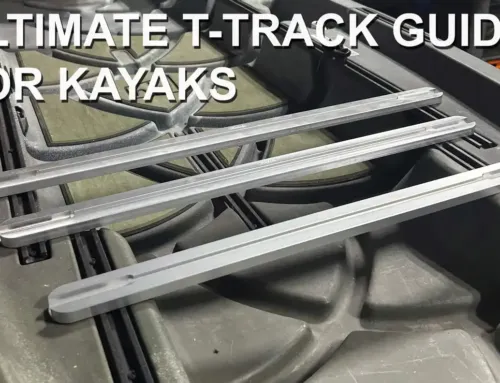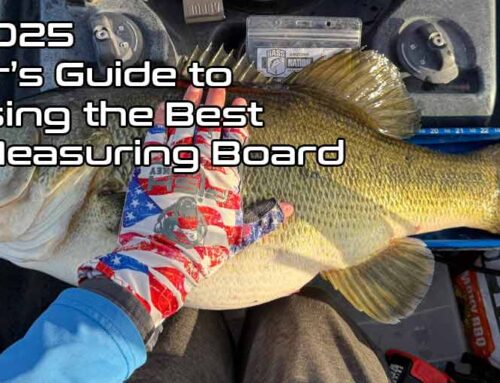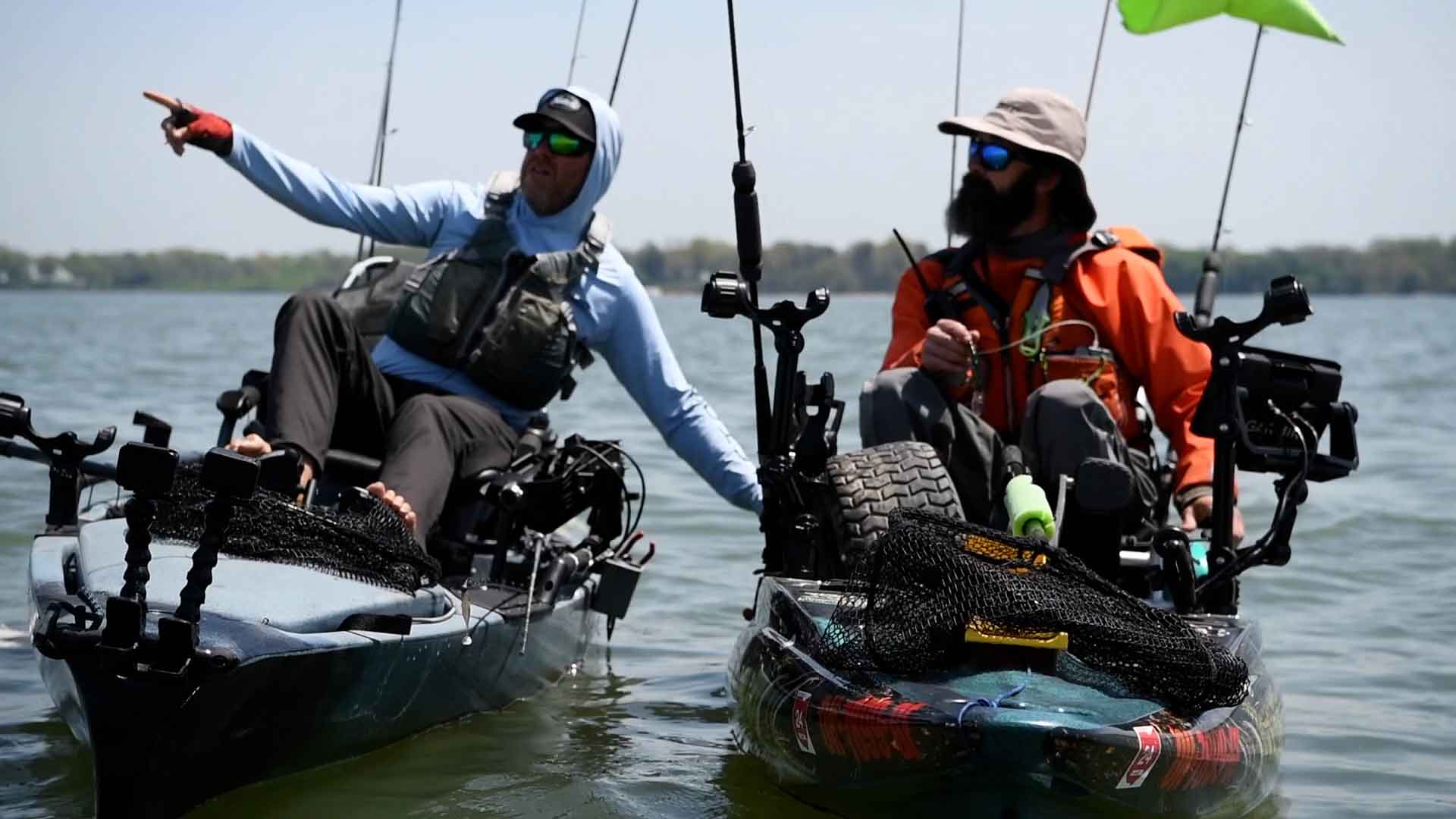

Ultimate Guide to Kayak Motors and Mounts for Fishing
Table of Contents
- Introduction
- Push or Pull? The Two Motor Styles That Define Your Ride
- What to Look for in a Kayak Motor
- Understanding Kayak Motor Mounts
- Installation Guide for Kayak Motors and Mounts
- Bow Mount Trolling Motor Mounts
- Stern Mount Motor Mounts
- Kayak Trolling Motor Setup Guide
- Popular Accessories for Kayak Motors
Introduction
Why Add a Motor to Your Kayak?
If you’ve ever fought wind, current, or fatigue in a paddle-only kayak, you already know the pain. Electric motors don’t just solve those problems, they redefine the game. Whether you’re a tournament angler chasing distant points or a weekend warrior looking for hands-free positioning, a motorized kayak setup gives you:
-
Greater range
-
More control
-
Less physical effort
-
More time actually fishing
But slapping a motor on a kayak isn’t plug-and-play. It requires a well-designed mount that’s rock-solid and precision-engineered. A flimsy setup creates drag, drains your battery, and vibrates like a lawnmower at full tilt. The right motor and mount combo, however, transforms your kayak into a quiet, efficient fishing machine.
In this guide, we’ll walk you through everything, from choosing the right motor and mount to optimizing your setup for performance, safety, and serious angling.
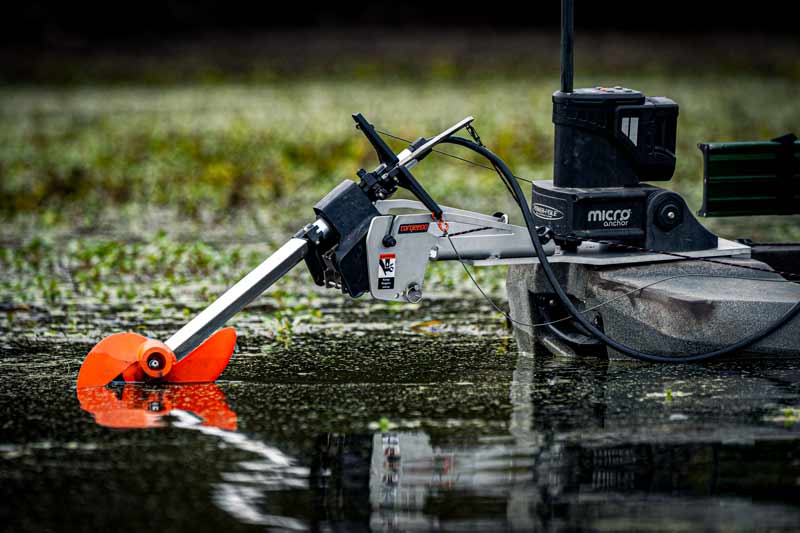
Stern Mounted Trolling Motor
Mounted on a Bonafide SS127 Kayak with a Ketch Motor Mount
Push or Pull? The Two Motor Styles That Define Your Ride
Kayak motors come in two main flavors, and your choice changes everything, from how your kayak handles to how you fish.
🚀 Transom (Stern) Mount Motors
These attach to the rear and push your kayak forward. Think of them like a mini outboard, straightforward, powerful, and efficient. Models like the Newport NK180 or Torqeedo 1103/403 are popular for anglers who cover serious water or fish fast-moving rivers.
Best for:
-
Covering long distances
-
Hands-free fishing (when paired with foot or rudder steering)
-
Simpler setups on most fishing kayaks
🎯 Bow Mount Motors
These pull your kayak from the front and are prized for precision. Think surgical strikes instead of blunt force. Many feature GPS capabilities like SpotLock®, which lets you “anchor” electronically with pinpoint accuracy, ideal for offshore, wind-blown, or current-heavy conditions. Motors like the MotorGuide Xi3 were favorites (until recently discontinued), while some Minn Kota models can be adapted for kayaks with some shaft trimming.
Best for:
-
Fine control in wind/current
-
Offshore holding with GPS
-
Precise boat positioning for casting
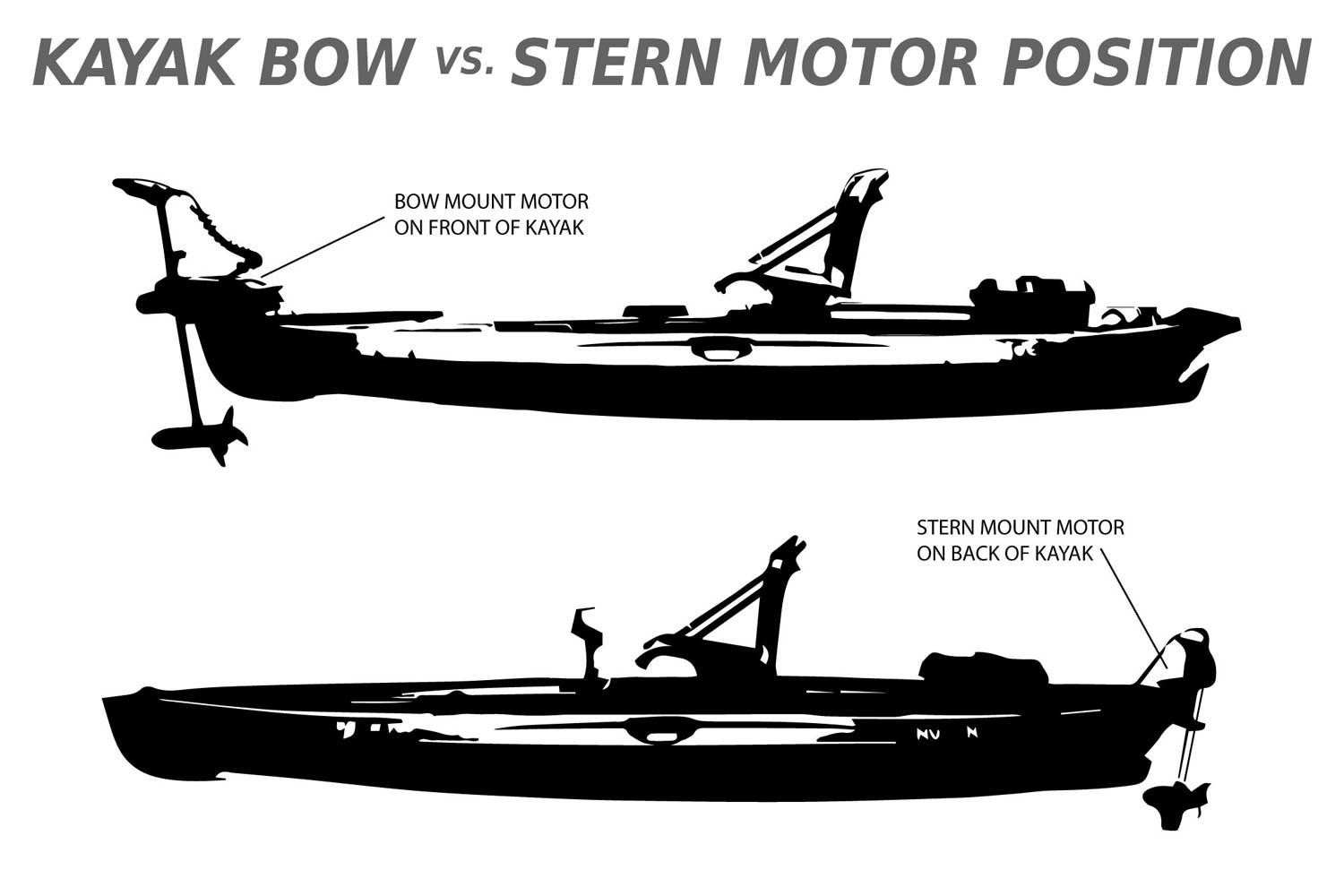
- Transom mounts: The motor is attached to the stern of the boat. These are motors like the Torqeedo Ultralight 1103 or 403 AC, or the Newport Vessels NK180 or NK300 for example, a motor of this type pushes the kayak through the water.
- Bow mounts: Ideal for precise maneuvering they pull the kayak from the front, and may even include GPS positioning to hold your kayak in position without the use of an anchor. These are usually bow mounted trolling motors intended for boats, but some models work great on kayaks, and a few have kayak specific models.
What to Look for in a Kayak Motor
Not all motors, or kayaks, are built the same. Here’s what to weigh before you bolt one down.
Choosing the right motor isn’t just about brand or thrust. It’s about pairing the right tool with the right platform for the way you fish. Here’s what should guide your decision:
✅ Kayak Compatibility
Your hull matters. Some kayaks have molded motor mounts or PowerPole inserts, others don’t. Make sure your motor (and mount) matches your kayak’s stern, bow, or track system without needing major surgery.
✅ Saltwater-Ready Materials
Fishing brackish bays or coastal water? Corrosion is your enemy. Look for motors and mounts built with marine-grade aluminum, stainless hardware, and sealed electronics.
✅ Balanced Thrust & Weight
A 70-lb thrust motor on a lightweight kayak? Overkill. Too small a motor? You’re just draining batteries without real speed. Match motor thrust to your kayak’s loadout and length for peak efficiency.
✅ Easy Install & Removal
Transporting a kayak isn’t like trailering a bass boat. You want a setup that’s secure on the water, but quick to break down when it’s time to load up or hit a tournament.
✅ Control System Fit
Think about how you want to drive. Foot pedal? Remote lanyard? Tiller handle? Make sure your kayak layout leaves room and rigging options for your preferred steering style.
Even if your kayak is “motor-ready,” that doesn’t always mean it’s motor-optimized. Factory mounts often lack the rigidity or angle precision required for higher-thrust motors. That’s where well-engineered solutions, like those from Ketch, come in, minimizing vibration, maximizing efficiency, and giving you the confidence to run full throttle without worry.
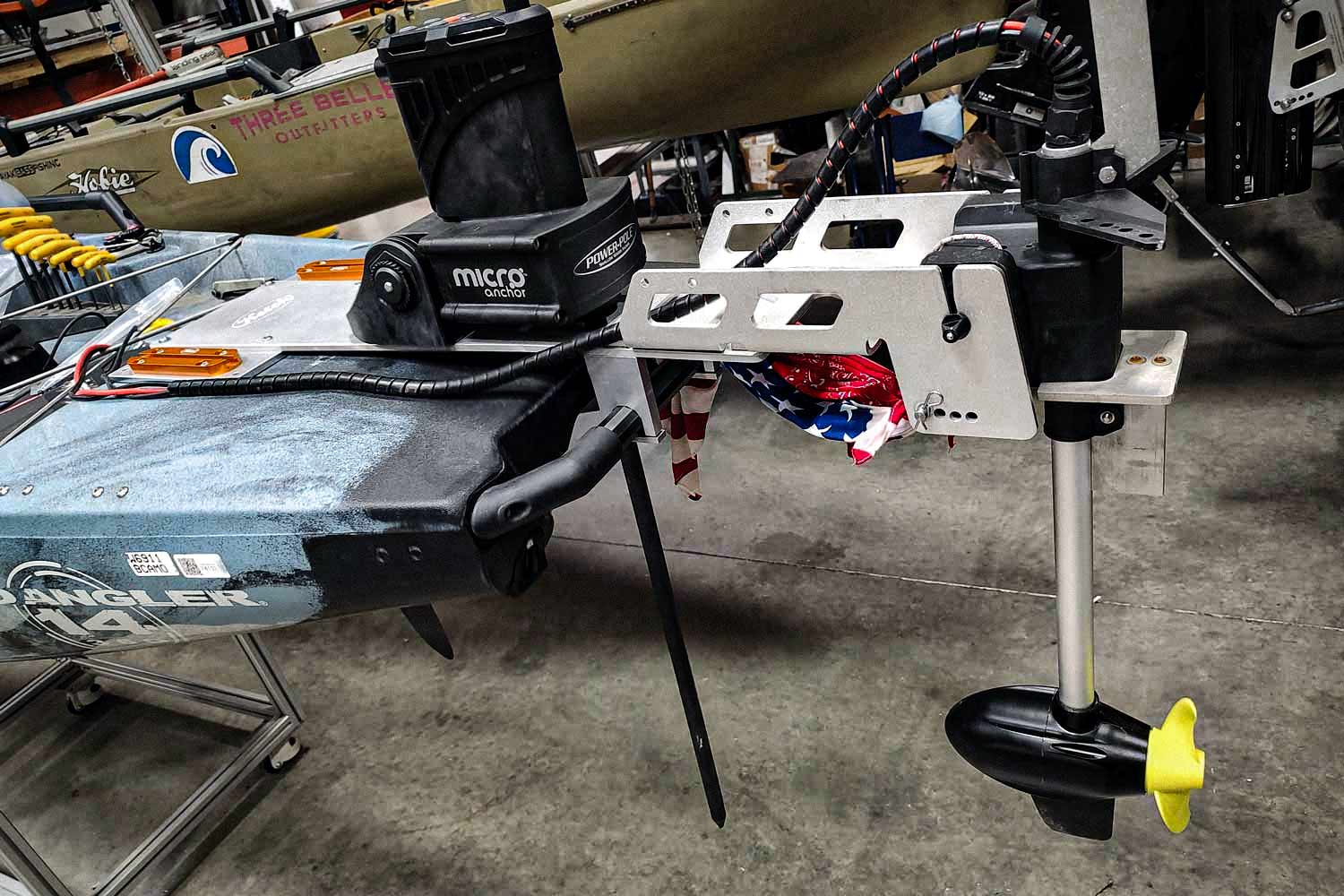
Stern Mounted Trolling Motor
Ketch Stern Mount for Hobie® PA14 Kayak
As motorized kayaking grows, brands are stepping up with factory-ready mounts and accessories, but smart anglers know that aftermarket systems often deliver the precision and power those stock parts can’t to deliver the maximum output and efficiency from your electric motor.
Understanding Kayak Motor Mounts
Types of Kayak Motor Mounts
Not all motor mounts are created equal. Your choice depends on your kayak, your motor, and how you fish. Here’s a breakdown of the most common types:
-
Universal Motor Mounts
Designed to fit a wide range of kayaks, these are perfect if your kayak wasn’t built with motorization in mind. They provide a stable base for tiller-style trolling motors and are usually straightforward to install. -
Adjustable Motor Mounts
While these don’t offer much in terms of efficiency or speed, they provide a flexible solution for unique hull shapes. If your kayak doesn’t match up with any bolt-on options, this might be your only play. -
Lightweight Mounts
Made from aluminum or composite plastics, these are ideal for paddlers who prioritize portability and easy installation. They offer strength without adding bulk, making them great for those who launch solo or need to carry their rig farther.
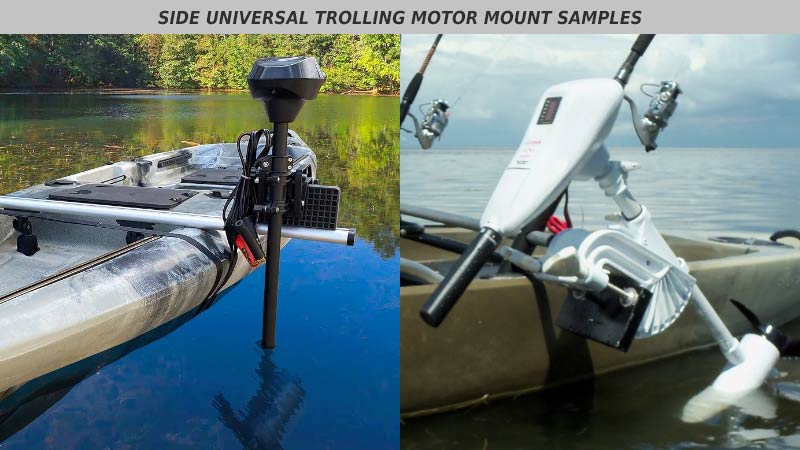
Universal Mounts for Trolling Motors on Kayaks
Side mounting trolling motor options
Bow Motor Mounts
Bow motor mounts allow you to install a trolling motor on the front of your kayak. This configuration pulls the kayak rather than pushing it, which gives you more control in wind, current, or tight fishing spots. Most bow-mounted motors use handheld remotes for steering and often support advanced features like GPS anchoring (SpotLock®), which keeps you positioned without dropping a physical anchor.
These mounts are typically made from either plastic or aluminum, and many support quick-release brackets. That makes them easy to remove when trailering your kayak or carrying it to the water. While the remote control offers flexibility, it does require you to take a hand off your rod, which is something to consider if hands-free operation is a top priority.

Bow Mounted Trolling Motor on Bonafide PWR129
Motor Guide Xi3 Bow Mounted Trolling Motor
Stern Motor Mounts
Stern motor mounts let you attach an electric motor to the rear of your kayak. Think of it like turning your kayak into a mini outboard-powered vessel. These motors push you through the water and are often used as the primary means of propulsion while fishing.
Many stern-mounted systems integrate with your kayak’s foot or hand steering, allowing for hands-free operation. That means you can keep casting or working a bait while maintaining your heading. This setup is especially popular with anglers who prefer a fast-paced, cover-water approach or who fish in current where precise boat control matters.
This rear-mounted configuration also keeps the front deck clear, giving you more room for gear or unobstructed casting.
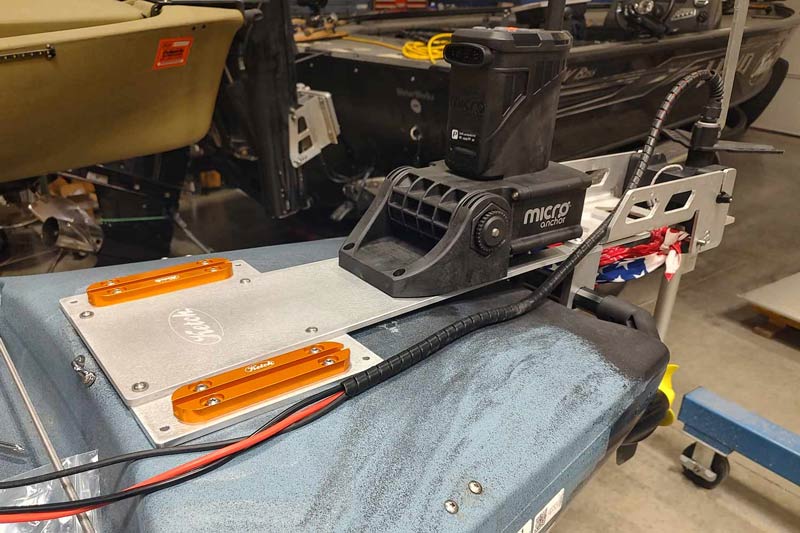
Ketch Stern Motor Mount
On Hobie® Kayak with Stern Mounted Motor
DIY Kayak Motor Mount Options
If you’re handy with tools and like the idea of a custom setup, a DIY motor mount can be a rewarding and budget-friendly solution. You can build a mount using materials like PVC, wood, or metal brackets, shaped to fit your specific kayak and motor combo. This gives you the flexibility to create a mount where no commercial option exists.
Online communities, YouTube tutorials, and kayak forums are goldmines for guidance. You’ll find step-by-step builds, supply lists, and tips to avoid common pitfalls. Whether you’re building something temporary for experimentation or a long-term solution, the DIY path offers full control over your design.
That said, DIY comes with trade-offs. Most homemade mounts lack the structural engineering of commercial options. They’ll get your motor on the kayak, but you may notice more vibration, reduced speed, or less efficiency. It’s a great option for tinkering, but not always the best choice for serious performance.
Best Kayak Motor Mounts for Fishing
When it comes to fishing, your motor mount is more than just a bracket, it’s the foundation of your entire setup. You need something solid, quiet, and reliable under pressure.
Some of the top mounts for kayak anglers are built to accommodate high-performance motors like the MotorGuide Xi3 or Newport NK180. Among the most trusted options are Ketch Products mounts. They’re built from aluminum for maximum rigidity and minimal vibration, which translates to better speed and smoother handling.
Ketch mounts are also engineered to position your motor at the ideal angle, helping you maximize efficiency and performance on the water. If your motor is the engine, the mount is the chassis. Go with one that’s built to fish hard, not just bolt on.
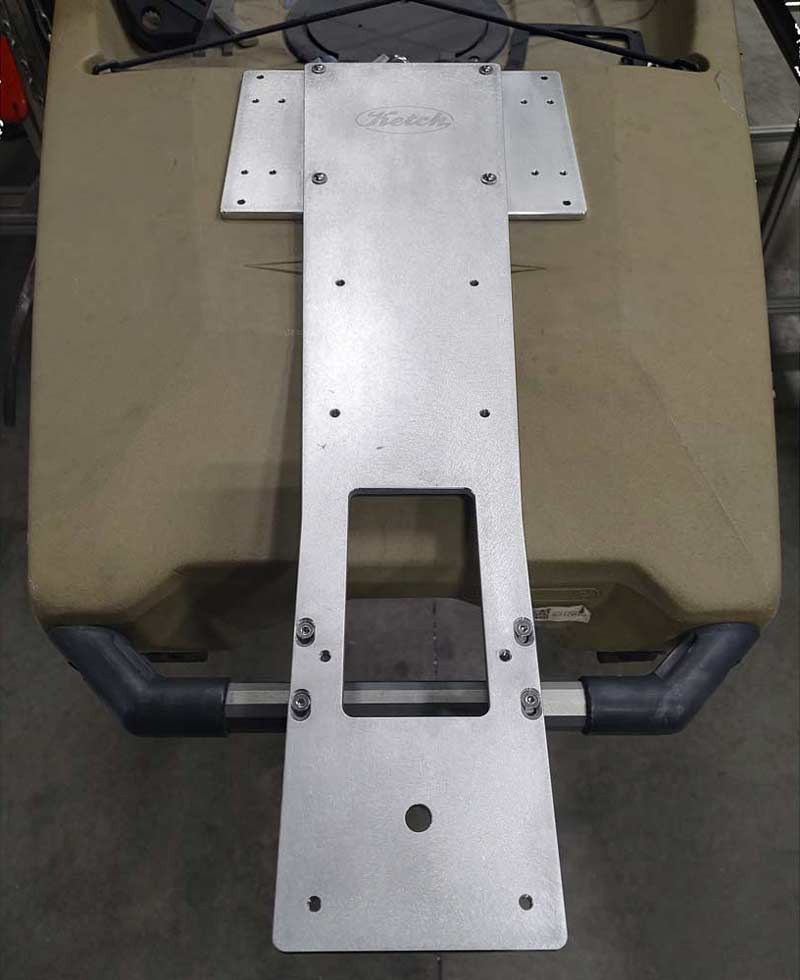
Sample of Ketch Motor Mount
Stern Motor Mount for Hobie® PA14 Kayak
Installation Guide for Kayak Motors and Mounts
Installing a motor on your kayak doesn’t have to be complicated, but it does have to be precise. Start by choosing a mount that fits both your kayak and your motor. Compatibility is critical. Even a high-quality motor won’t perform well if it’s mounted on an unstable or misaligned bracket.
Once you’ve confirmed your components work together, follow these general steps:
-
Choose Your Mounting Location
Decide between bow or stern based on your kayak design and fishing style. Stern mounts are often easier for DIY installs, while bow mounts may require reinforced plates or additional hardware. -
Install the Mount
Follow the manufacturer’s instructions closely. Most quality mounts will include stainless steel hardware. Use a drill, wrenches, and sealant where needed to ensure a rock-solid fit that won’t shift under power. -
Secure the Battery
Place your battery in a dry box and mount it in a spot that maintains balance, usually behind the seat or in the front hatch. Use straps or brackets to keep it from sliding around. -
Wire It Up
Run wiring through your hull using marine-grade connectors and waterproof glands. Don’t forget a circuit breaker near the battery for safety. -
Mount the Motor
Once the mount is secure and wiring is done, attach your motor and adjust the shaft height. Make sure the prop sits below the hull without dragging in shallow water. -
Test Before You Launch
Do a full-function check on land or in shallow water. Make sure the motor powers on, turns freely, and all connections are secure.
A clean install should feel like the motor was meant to be there, not like an add-on. Take your time and double-check your alignment, especially if you’re running higher-thrust motors. It’s worth the effort for smoother, more efficient performance on the water.
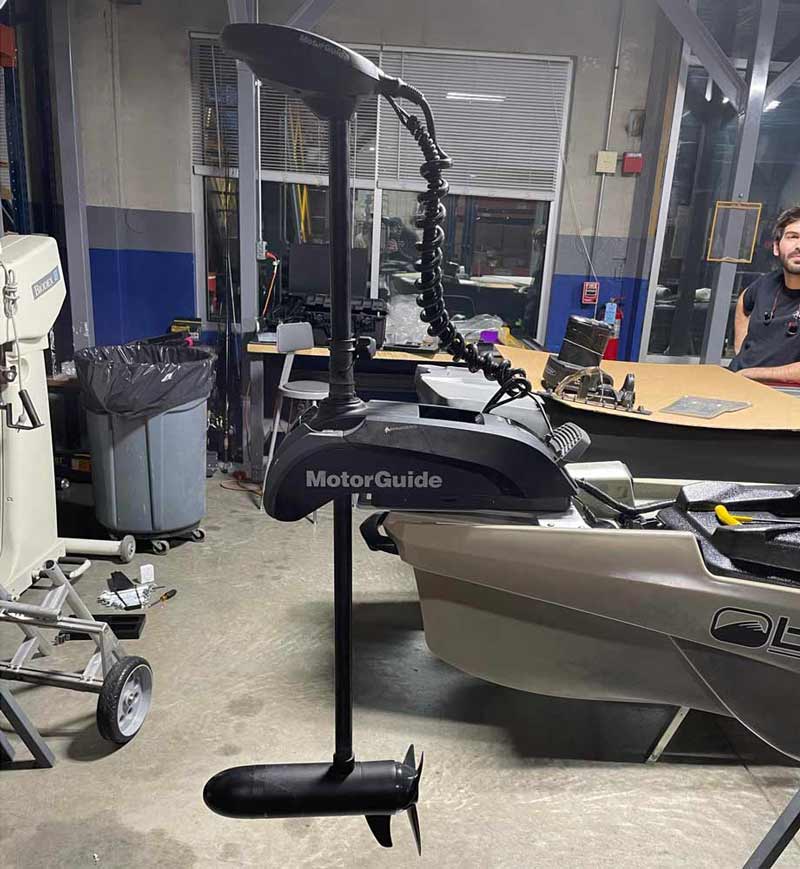
Bow Motor Mounted on
Bonafide® PWR129 Kayak with Ketch Motor Mount
A solid install isn’t just about bolting things down, it’s about balance, alignment, and load handling. Pay special attention to steering integration on stern mounts, and be prepared to upgrade internal rudder systems or cables if your factory setup wasn’t built for motorized torque. Test everything in calm water before trusting it in current.
Bow Mount Trolling Motor Mounts
Benefits of Bow Mount Trolling Motors
Superior Control in Tight Spots
Bow-mounted motors excel at precision. They pull the kayak from the front, making it easier to steer around obstacles like weed lines, rocks, or dock pilings. This gives you tighter maneuverability, ideal for working small target areas.
Stability in Wind and Current
With the motor pulling from the bow, your kayak tracks straighter in tough conditions. That means less drifting, better boat control, and fewer missed casts when the wind picks up.
GPS Positioning Advantage
Bow-mounted motors often support GPS features like Spot-Lock, which can “anchor” you in place with the push of a button. It’s a huge asset for offshore fishing, current breaks, or anytime you want to hold a specific position without dropping a physical anchor.
Remote Control Trade-Offs
Most bow motors are controlled via handheld remotes, usually worn on a lanyard. While effective, this setup does require one hand off your rod, which some anglers find inconvenient compared to foot-pedal options on traditional boats.
Important Note on Availability
As of now, the MotorGuide Xi3, a top choice among kayak anglers, has been discontinued. While some Minn Kota models can be adapted, they may require shaft modifications since a kayak-specific model isn’t currently available.
Types of Bow Mount Trolling Motor Mounts
Bow mount brackets come in a range of designs and materials. Here are the main categories:
-
Heavy-Duty Brackets
Built to handle bigger motors and tougher water, these are ideal for larger kayaks or aggressive offshore use. -
Aluminum Mounts
The gold standard for strength and vibration control. Lightweight but rigid, these mounts help your motor perform more efficiently by reducing flex and energy loss. -
Quick-Release Compatible
Many bow mounts are designed to accept quick-release brackets for faster setup and breakdown. This makes transport and storage much easier, especially when switching between powered and paddle-only trips.
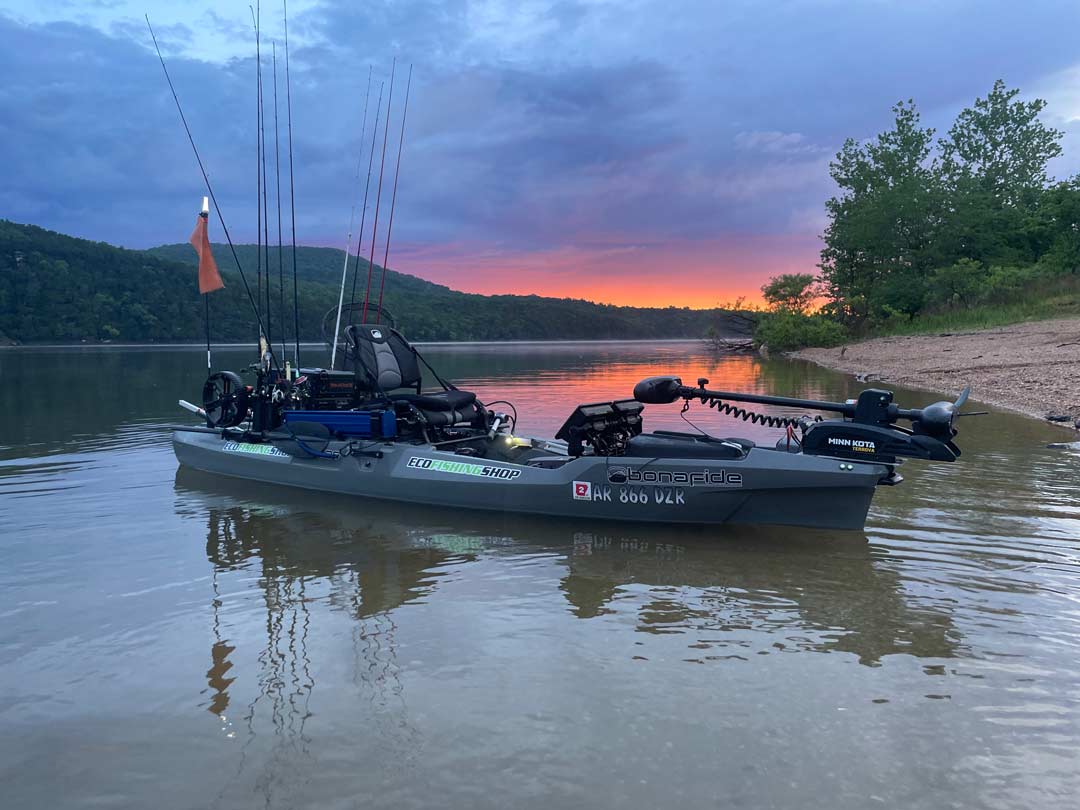
Stern Mount Motor Mounts
Benefits of Stern Mounted Motors
Keeps the Front Deck Clear
Stern-mounted motors sit out of your way, giving you full access to the front hatch and casting area. If you like a clean workspace or need to store gear up front, this is a big win.
Flexible Steering Options
Rear motors can be controlled via tiller handle, remote, or integrated with your existing foot or hand steering. For anglers who want a hands-free experience, this setup can be customized to run like a mini bass boat.
More Speed and Better Efficiency
Mounting the motor at the stern often helps lift the bow slightly under power, reducing drag and increasing speed. If you’re covering lots of water, or fishing big lakes, this layout gives you an edge.
Not a One-Size-Fits-All Decision
Stern mounts are great for run-and-gun anglers, but may not suit every kayak or fishing style. Always weigh your priorities: deck layout, control method, and how you fish.
Kayak Trolling Motor Setup Guide
Essential Components for a Kayak Trolling Motor Setup
To set up a complete trolling motor system, you’ll need:
Core Components
-
Trolling motor (12V or 24V, 30–70 lb thrust)
-
Lithium battery (12V 100Ah or 24V 50Ah recommended)
-
Motor mount (compatible with your kayak)
-
Battery box or crate
-
Circuit breaker or fuse
-
Wiring, connectors, and a waterproof switch
Tools You’ll Likely Need
-
Drill and bits
-
Screwdrivers
-
Allen and socket wrenches
-
Wire strippers and crimpers
-
Marine-grade sealant
-
Zip ties or cable mounts
These essentials form the backbone of a safe, functional, and high-performance setup.
Step-by-Step Installation Process
Note: This is a general overview. Always follow the exact instructions for your specific gear.
-
Pick the Mounting Location
Choose stern or bow based on your kayak design and how you fish. -
Install the Motor Mount
Use the included hardware and follow the manufacturer’s instructions. Tighten everything down with stainless steel bolts and seal where needed. -
Secure the Battery
Place it low in the kayak to maintain balance, and strap it down inside a waterproof box or crate. -
Add the Circuit Breaker or Fuse
Mount this close to the battery’s positive terminal to protect your wiring and motor. -
Run the Wiring
Route cables cleanly inside the hull or along rigging tracks. Use waterproof connectors and strain relief where appropriate. -
Mount the Motor
Attach it to your bracket, adjust the shaft height, and double-check alignment. -
Test Everything on Dry Land or Calm Water
Confirm that steering, throttle, and connections are all working correctly before your first real outing.
Optimization Tips
-
Use lithium batteries to save weight and extend runtime. They’re pricey, but the performance gain is worth it.
-
Run your motor at 80% or lower to conserve power without sacrificing too much speed.
-
GPS-enabled bow motors are ideal for precision anglers.
-
Use waterproof quick-connects to simplify wiring and battery swaps.
-
Rinse and clean all components after saltwater use to prevent corrosion.
Safety Considerations
-
Know Your Load Limit: Make sure your kayak can handle the combined weight of you, your gear, motor, and battery.
-
Add Required Lights: Motorized kayaks typically need red/green nav lights and a 360° white light, especially after dusk.
-
Register Your Kayak: Most states require registration numbers once a motor is added.
-
Use a Kill Switch or Remote Safety Line: Stern motors need a magnetic kill switch; bow motors should have a remote secured to your body.
-
Always Wear a PFD: No exceptions.
Following these tips keeps you legal and, more importantly, safe.
Popular Accessories for Kayak Motors
Enhancing your kayak with motor accessories can significantly improve your overall experience on the water.
Some of the most popular accessories include:
Motor Mounts, mounting plates specific to your kayak model to get the best angles and the most solid mounting to get the most speed out of your motor.
Quick Connect Brackets, these help you quickly remove your bow mount trolling motor from your kayak for transport or storage.
Wiring Quick-connects, which makes the process of attaching and detaching your motor and battery from the kayak easy.
Wiring Kits, if your kayak was wired for a motor, sometimes the factory wiring is less than ideal and you can get more efficiency and safety with an upgrade to the correct size wire for adding a motor.
Circuit breakers or fuses, which adds a layer of safety to your setup by preventing electrical overloads and possibly fires on the water which can absolutely ruin your day and your kayak.
LED navigation lights for increased visibility during low-light conditions, and are usually required when adding any electric motor to your kayak.
Advanced Steering Systems, for the stern mounted motors you may benefit from upgraded parts for using your existing steering handles, or even steering just for the motor like foot steering and independent steering handles for your motor only.
Upgraded Rudders, these may be necessary or very helpful to those two add a motor because stock rudders are usually not designed for use with motors and may not have the surface area or rigidity required for the added pressures applied to them when using a motor.
Upgraded Steering cables, just like the rudder your steering cables may not be up to par for the added pressures of operating while under power and the added stress may cause your cables to break prematurely.
Upgraded Steering Handles, this one is mostly for appearance, but we’ve seen a few complaints about people breaking stock steering handles under the added pressure of a motor, these not only are aluminum but they also come in anodized colors to make your kayak stand out.
Rock Guards, these are primarily used for stern mounted motors and can help keep your propeller safe when operating in rocks or shallow water.
Popular Accessories for Kayak Motors
Leveling up your motorized kayak setup often comes down to the right accessories. Here’s what most anglers add:
-
Motor Mounts: Specific to your kayak for better fit, efficiency, and angle alignment.
-
Wiring Quick-Connects: Make removing or swapping your motor fast and simple.
-
Upgraded Wiring Kits: Better cable gauge = better power delivery and safety.
-
Circuit Breakers/Fuses: Protection against shorts or overloads.
-
Navigation Lights: Required for nighttime and motor use in many states.
-
Steering Upgrades: Independent foot or hand control systems for stern-mounted motors.
-
Rudders: Larger, stronger options to handle motor-powered steering loads.
-
Steering Cables & Handles: Heavy-duty replacements for added torque and reliability.
-
Rock Guards: Shield your prop from debris and shallow-water damage.
Improving Your Kayak Fishing Experience with Motor Accessories
The right accessories don’t just make things easier, they make you a better angler. Better steering means tighter turns. Cleaner wiring means faster prep. Proper lighting keeps you visible and legal.
You don’t need every upgrade, but investing in the ones that fit your fishing style can dramatically improve your comfort, efficiency, and confidence on the water. When your gear works with you instead of against you, you spend more time fishing, and less time fixing.
Conclusion
Outfitting your kayak with a trolling motor isn’t just about convenience. It’s about unlocking new potential on the water. Whether you’re chasing distant points, fighting through current, or simply fishing longer without fatigue, a motorized setup puts more opportunity within reach.
The key is choosing components that match your kayak and your fishing style. Bow-mounted motors offer unmatched control and GPS precision, while stern-mounted options give you simplicity, speed, and a clean deck. Paired with the right mount and accessories, your kayak becomes a finely tuned fishing machine.
As motor technology and battery systems continue to improve, anglers will see more options, smarter features, and better integration with modern kayaks. That means easier installs, better performance, and fewer compromises.
If you build it right from the start, your motorized kayak will do more than float. It will work with you, keep you efficient, and help you stay focused on what matters most, fishing.

What does the future look like
For Kayak Motors?
Ready to Rig Your Kayak?
Before you hit the water, remember:
-
Match the motor to your kayak’s weight and layout
-
Choose a mount that fits tight and runs true
-
Use quality wiring and safety gear
-
Test everything in calm water first
-
Upgrade accessories to fit your fishing style
A well-rigged kayak doesn’t just take you farther. It makes every cast count.

